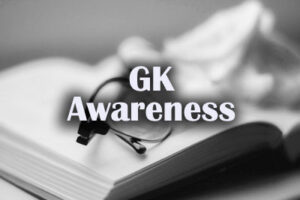Typical Questions on General Awareness for all Competitive Exam
Interested users can download the Typical Questions on General Awareness from the links enclosed below. Download the Last 5 Years Typical Questions on General Awareness Solved along with the Answers of each question.

This Typical Questions on General Awareness may vary from the Actual paper. Use the Typical Questions on General Awareness as a reference for the exam preparation. Check the Typical Questions on General Awareness from this page.
At the bottom of this page, you will find ‘Click here links’ for downloading the Typical Questions on General Awareness. Click on the required link & download your related Typical Questions on General Awareness to make as a reference for your scheduled preparation.
GK Typical Questions
1. Which scientist discovered the radioactive element radium?
(a) Isaac Newton
(b) Albert Einstein
(c) Benjamin Franklin
(d) Marie Curie
2. Who invented Electric Generator?
(a) Sir Alexander Graham Bell
(b) Michael Faraday
(c) Alfred B.Nobel
(d) Thomas Alva Edison
3. What did Sir Isaac Newton invent?
(a) Reflecting telescope
(b) Chronometer
(c) Microscope
(d) Spectacles
4. Who invented Fountain Pen?
(a) John J.Loud
(b) Sir Frank Whittle
(c) Lewis E.Waterman
(d) Kirkpatrick Macmillan
5. The first Indian to receive Noble Prize in Literature was
(a) Mother Teresa
(b) C.V.Raman
(c) Rabindranath Tagore
(d) Sarojini Naidu
6. The only Indian to win the Nobel prize in physics is
(a) Dr. J.C.Bose
(b) Dr. C.V.Raman
(c) Dr. Vickram Sarabhai
(d) Dr. H.J.Bhabha
7. The five permanent members of UN security council are
(a) Japan, West Germany, USSR, UK and USA
(b) Canada, China, France, USSR and USA
(c) Germany, China, USSR, UK and USA
(d) China, France, USSR, UK and USA
8. The minimum age to qualify for election to the Lok Sabha is
(a) 25 years
(b) 21 years
(c) 18 years
(d) 35 years
9. The members of the Rajya Sabha are elected for a term
(a) of six years
(b) determined by the state legislative assembly of a state
(c) of four years
(d) of five years
10. The oath of office is administered to the Governor by the
(a) Chief Justice of India
(b) President
(c) Chief Justice of high court
(d) Speaker of Legislative Assembly
11. The preamble to our Constitution provided that India is
(a) a sovereign, socialist and democratic republic
(b) a sovereign, socialist, secular and democratic republic
(c) a sovereign republic with a socialist pattern of society
(d) a socialist, secular and democratic republic
12. The members of the State Public Service Commission are appointed by
(a) Chief Minister
(b) Chief Justice
(c) Governor
(d) Vice-president
13. The birthday of which of the following leaders in India is observed as Children’s day?
(a) Mahatma Gandhi
(b) S.Radhakrishnan
(c) Rajiv Gandhi
(d) Jawaharlal Nehru
14. Which city is known as ‘Electronic City of India’?
(a) Mumbai
(b) Hyderabad
(c) Guragon
(d) Bangalore
15. Which of the following is used in pencils?
(a) Graphite
(b) Silicon
(c) Charcoal
(d) Phosphorous
16. The filament of an electric bulb is made of
(a) tungsten
(b) nichrome
(c) graphite
(d) iron
17. LPG consists of mainly
(a) methane, ethane and hexane
(b) ethane, hexane and nonane
(c) methane, hexane and nonane
(d) methane, butane and propane
18. Optical fibre works on the
(a) principle of refraction
(b) total internal reflection
(c) scattering
(d) interference
19. Plants receive their nutrients mainly from
(a) chlorophyll
(b) atmosphere
(c) light
(d) soil
20. Plants absorb most part of water needed by them through their
(a) embryonic zone
(b) growing point
(c) root hairs
(d) zone of elongation
21. Myopia is connected with
(a) Ears
(b) Eyes
(c) Lungs
(d) none of these
22. The first Indian state to install a system to detect earthquakes and disseminate warnings is
(a) Uttarakhand
(b) W.Bengal
(c) Gujarat
(d) Sikkim
23. Kathakati is a classical dance form of
(a) Tamil Nadu
(b) Telegu
(c) Kerala
(d) Kanada
24. The study of old writing used in inscription in historical construction is called
(a) Numismaties
(b) Epigraphy
(c) Palaeography
(d) Archaeology
25. Which of the following is one of the remarkable characteristics of Harappan cities?
(a) Use of burnt bricks
(b) Great bath
(c) Drainage system
(d) All of these
More Question Set on General Studies
| Model Question | Old Question |
| Sample Papers | Mock Test |
| Practice Set | Question Bank |
| Important Questions | Test Papers |
| Typical Questions | Selected Questions |
26. The Iranian ruler who penetrated into north-west India in 516 BC and annexed Punjab, west of Indus and Sindh was
(a) Xeres
(b) Magadhan
(c) Darius
(d) Alexander
27. Who among the following is associated with Kalinga war?
(a) Ashoka
(b) Bindusara
(c) Chandragupta
(d) Gautamiputra
28. Who is called ‘Napoleon of India’ because of his bravery and generalship?
(a) Samudragupta
(b) Chandragupta-II
(c) Skandagupta
(d) Anugangagupta
29. “Not me but you” is the motto of
(a) NSS
(b) NCC
(c) NYC
(d) SAI
30. In which of the following states no community has been specified as a scheduled tribe?
(a) Chandigarh and Delhi
(b) Haryana and Punjab
(c) Goa and Puducherry
(d) Mizoram and Meghalaya
31. Heavy water in a Nuclear reactor is used as
(a) Stabiliser and Dilutant
(b) Lubricant and Sealant
(c) Moderator and Coolant
(d) None of these
32. The material that can be used to convert solar energy into electricity is
(a) Mica
(b) Aluminium
(c) Silicon
(d) Silver
33. The compounds used for sterilisation which are harmful to living tissues are
(a) Antipyreties
(b) Disinfectants
(c) Analgesics
(d) Antiseptics
34. The country whose capital is Lusaka is
(a) Rwanda
(b) Burundi
(c) Angola
(d) Zambia
35. The instrument generally used for determining the radius of curvature of spherical surfaces is
(a) Screw gauge
(b) Vernier caliper
(c) Spherometer
(d) Micrometer screw
36. Choose the odd one out in terms of dimensional unit
(a) Specific gravity
(b) Strain
(c) Stress
(d) None of these
37. Celebration of National Voters Day on 25th January every year is a strategy to
(a) promote free and fair election nationwide
(b) encourage reducing the election related expenditures
(c) increase enrolment of voters
(d) discourage possible communalism in the politics
38. The place of origin of an earthquake inside the surface of the earth is called its
(a) Seismos
(b) Shear centre
(c) Focus
(d) Epicentre
39. Ozone layer is concentrated above the surface of the earth mainly between
(a) 10 to 50 km
(b) 15 to 80 km
(c) 20 to 100 km
(d) 30 to 120 km
40. Which of the following states has the highest reserve iron ore deposit in India?
(a) Bihar
(b) Odisha
(c) Rajasthan
(d) Gujarat
41. Heavy Electrical (India) Ltd., to manufacture heavy electrical equipment was set up in 1956 at
(a) Ranchi
(b) Warangal
(c) Bhopal
(d) Nagpur
42. Who among the following has become the President of India twice?
(a) Dr.Zakir Hussain
(b) B.D.Jatti
(c) V.V.Giri
(d) Neelam Sanjiva Reddy
43. The famous Kamakhya Temple is located in
(a) Odisha
(b) Andhra Pradesh
(c) Assam
(d) Karnataka
44. Special Category States was introduced in 1969 and was originally granted to three states, namely
(a) Arunachal Pradesh, Himachal Pradesh and Manipur
(b) Assam, Manipur and Meghalaya
(c) Nagaland, Jammu & Kashmir and Himachal Pradesh
(d) Assam, Nagaland and Jammu & Kashmir
45. The Schedule in the Constitution of India which contains provisions for allocation of seats for each state in the Rajya Sabha is
(a) First Schedule
(b) Fourth Schedule
(c) Ninth Schedule
(d) Tenth Schedule
46. The full form of SARDP-NE is
(a) Special Accelerated Road Development Programme in North East
(b) Special Accelerated Railway Development Programme in North East
(c) Sustainable Animal and Range Development Programme in North East
(d) Stricken Aircraft Reclamation Disposition Program in North East
47. Which city is known as the ‘City of Nawabs’?
(a) Hyderabad
(b) Kolkata
(c) Lucknow
(d) Jaipur
48. Surat in Gujarat is known as
(a) Cultural City of India
(b) Sun City
(c) City of Diamond
(d) Maximum City of India
49. Which country is called ‘Isle of Pearls’?
(a) Yemen
(b) UAE
(c) Bahrain
(d) Oman
50. Who is called ‘Saint of the Gutters’?
(a) Mother Teresa
(b) Mary Catherine
(c) Maria Cannavale
(d) Maria Goretti


